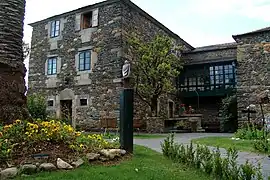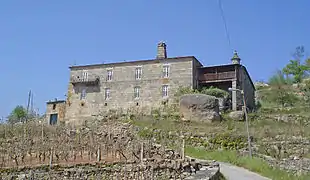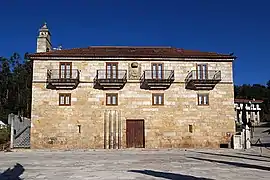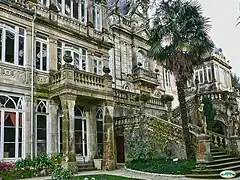
A Pazo is a type of Galician traditional house. Similar to a manor house, pazos are usually located in the countryside, as former residences of important people in the community (formerly of kings and nobility). They were of crucial importance in the 17th to 19th centuries, related to rural and monastic architecture and the system of feudal organization, and they constituted a type of local management unit around which the life of the villagers revolved. Over time they become the social symbol and refuge of the noble class, which Otero Pedrayo portrayed in his novels in early 20th century.
The pazo, as a traditional civil architectural structure, had associated a social network: the servants of the nobleman and the tributaries of the domain, who themselves came to live on the grounds of the pazo (mostly the former). A pazo usually consists of a main building surrounded by gardens, a dovecote and often include outbuildings such as small chapels for religious celebrations. An example being the pazo de Cadro in Marin, the seat of the House of Romay, which had a chapel dedicated to Santa Barbara.
The word pazo is a cognate of stately palace, and comes from the Latin palatiu(m). As a curiosity, the Portuguese word, close to the Galician language, to say palace is paço (instead of palácio). In this regard, the Paço Imperial in Rio de Janeiro, built in the 18th century, is an example of the Portuguese counterpart of this type of building.
Gallery
 Pazo da Trave, Viveiro
Pazo da Trave, Viveiro Pazo Baión, Vilanova de Arousa
Pazo Baión, Vilanova de Arousa Pazo de Pousadouro, Redondela
Pazo de Pousadouro, Redondela Pazo Pondal, Ponteceso
Pazo Pondal, Ponteceso Pazo de Fefiñáns, Cambados
Pazo de Fefiñáns, Cambados Pazo de Oca, A Estrada
Pazo de Oca, A Estrada Pazo Bermúdez de Castro, Cotobade
Pazo Bermúdez de Castro, Cotobade Pazo de Leis, A Baña
Pazo de Leis, A Baña Casa grande de lentille en Cenlle
Casa grande de lentille en Cenlle Pazo de Mos, Mos
Pazo de Mos, Mos
 Pazo do Piñeiro, en Pesqueiras, Chantada.
Pazo do Piñeiro, en Pesqueiras, Chantada. Tower and pazo de San Miguel das Penas, Monterroso
Tower and pazo de San Miguel das Penas, Monterroso
